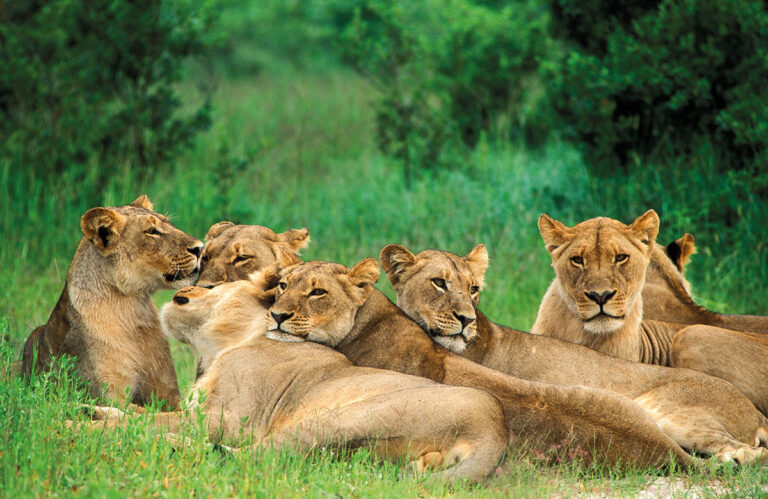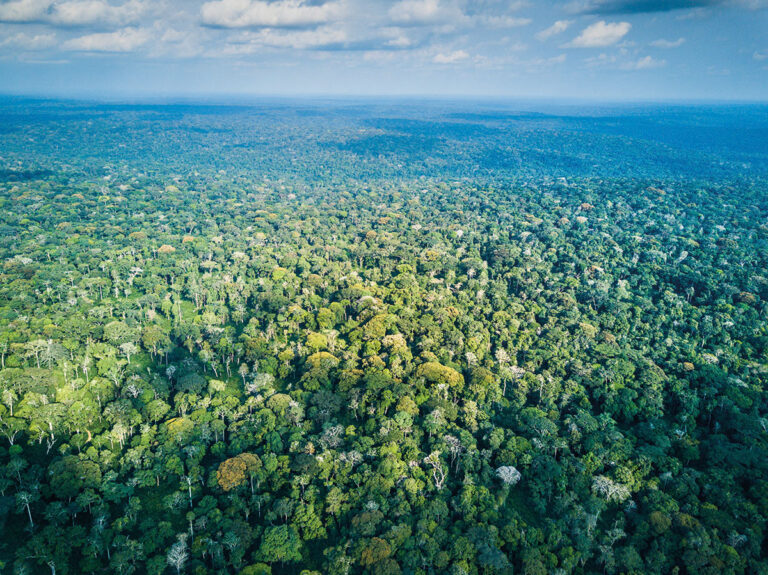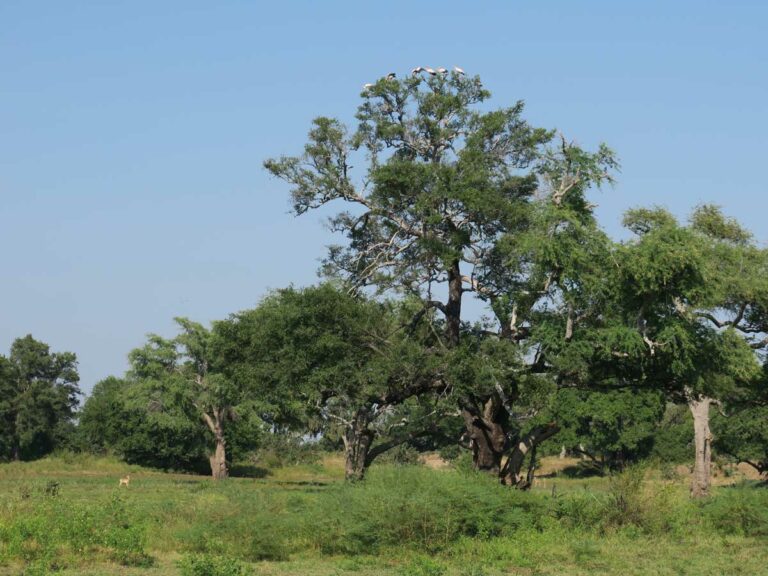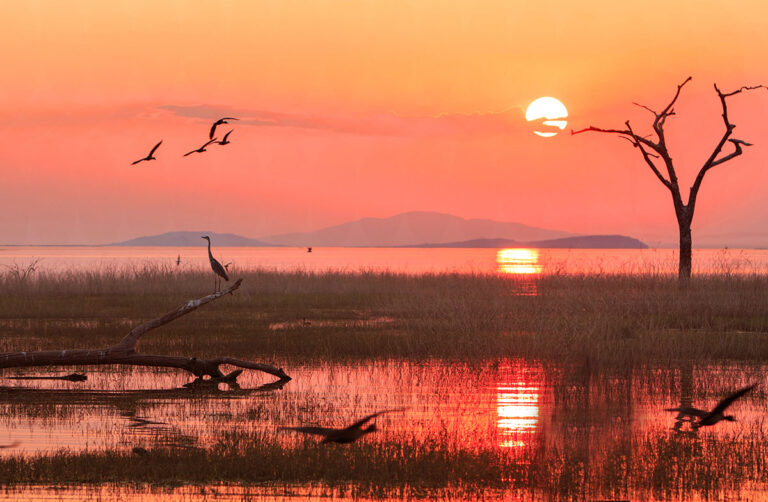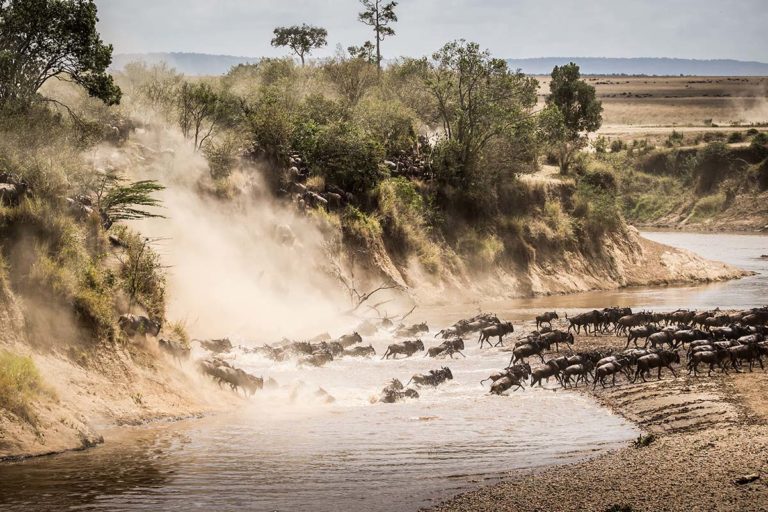The L word
Home » Editor's Pick » The L word
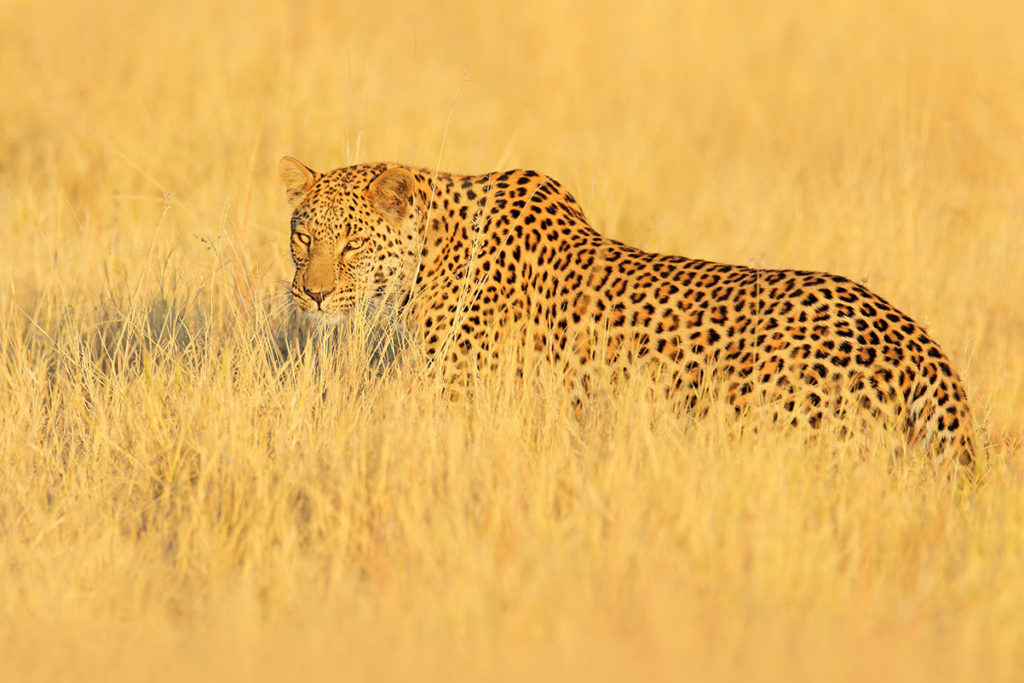
A personal tale of animal obsession… What feeds our fascination with Africa? How have our passions evolved, and where do we find fulfilment? Here, author Mike Unwin investigates his own very personal obsession. In his story, perhaps we recognise something of our own.
“Hold on. I think I saw… Was that some kind of… Can you go back a second?”
It’s around 7.45am on Friday 18 August, 1989. The words, or something similar, are my mother’s. They herald a moment that I have been trying to imagine for much of my life. Forget space travel or scoring the winner in the FA cup final. Forget Siberian tigers, blue whales, polar bears and other fantasy animal A-listers. One childhood dream has long crowded out all others, and its realisation is now just seconds away.
First, some context. This is day four of a safari in Hwange National Park, Zimbabwe. I’m sitting behind the wheel of a battered Mazda 323, my father beside me and my mother in the back seat. My parents and younger brother Nick are here for a holiday, my first visitors since I arrived in the country a year ago. I am working as an English teacher at a high school in Bulawayo – as is my wife: we got hitched last summer, when our contracts were confirmed. A year on, and I’ve thrown myself into all things African, shedding my English Home Counties skin – or so I imagine – and reinventing myself. Now, my family is here to witness the new me. It feels like a significant rite of passage.
But back to the story. This morning it’s only the three of us in the car. After an early start, we’re returning to camp via a dusty backroad called the Salt Springs Loop. Mum, hampered by her position in the back, has so far spotted little. Now, however, her urgency demands attention. I look around to see her gesturing right towards a flash of water half concealed behind the verge.
As I slip the car into reverse we all simultaneously lay eyes on what Mum has spotted: the lowered head and raised elbows of a large cat, drinking. Backlit by the early sun, the colours are hard to make out but the shape is unmistakable. At the crunch of tyres, it looks up. We have just seconds in which to fumble with binoculars before it slinks back into the long grass, but this is time enough for me to bring into focus the spotted hide and white curl of tail tip. “Leopard!” I say, first to get the word out. “Shit!” A pause. “Sorry Mum.”
So that’s it, then. My life’s ambitions fulfilled in about six seconds and at the tender age of 23. Not a great view – certainly no time for photographs – but a leopard, indisputably. What now? After this, things can surely only go downhill.
That morning was now nearly thirty years ago. Since then, I have seen many other leopards, not to mention plenty of other big cats around the globe. I’ve had ample time to contextualise that childhood obsession within broader frameworks of knowledge and experience.
As part of this maturing process, I’ve learned to rail against our anthropomorphic distortion of the natural world into some value-laden hierarchy: the good, the bad and the ugly of wildlife. How can we expect to understand nature, let alone make a decent stab at conservation, when we continue to stereotype the likes of leopards as “magnificent” and hyenas, say, as “disgusting”? Can’t we accept that every animal is simply adapted to meet the challenges of survival in its own way?
On a personal level, I’ve also discovered that liking leopards is nothing very original. The cat is near the top of most wildlife bucket lists, after all, universally admired as beautiful, enigmatic and so on. In taste terms, it’s the animal equivalent of admiring David Bowie or Roger Federer: impeccable, but hardly niche. Indeed, when asked to name my favourite animal, I seldom fess up. Either I purport to reject the very notion, explaining how I prefer to appreciate the natural world in all its holistic glory or, when I see eyes glazing over, trying to defy expectations with a more left-field candidate: dwarf mongoose, perhaps, or dunnock.
What’s more, the leopard has another life as imagery, co-opted into popular culture as shorthand for the slinky and sexy. Leopard print fashion – on, say, shoes or underwear – suggests the wearer shares the cat’s supposedly alluring qualities, while images of the cat itself are used to sex up anything from an insurance advert to some dubiously ‘artistic’ movie (Paul Schrader’s Cat People, anyone?). Either way, this popular commercial appeal has always felt vaguely embarrassing to the wannabe naturalist; something from which to distance yourself.
In short, you’d think that by now I might have got over my leopard obsession; that I’d have rationalised away this romanticising of one animal species above the countless others that are equally deserving of attention and respect. And yes, I’ve done my best. I’ve waxed lyrical about the weird critters and played it cool about the ‘iconic’ ones. But still it comes back to leopards. Try as I might, I can’t get enough of them.
I can’t pinpoint the precise spark that first lit the leopard flame, but I know it happened young. The influences are easily identified. A junior passion for wildlife, fed by a family interest in nature and nourished by a houseful of books, acquired a more aspirational dimension through my grandparents, whose diplomat postings in Africa produced a rich crop of safari stories. Thus, while collecting caterpillars in the back garden or seeing my first great spotted woodpeckers on the local common, I was simultaneously inhabiting a dream world of game rangers and the African bush.
The first real-life leopard story I heard was, indeed, from my grandparents. It was an archetypal encounter: the big cat up a tree in the Serengeti. The story didn’t come with photos but the image in my mind was indelible. For years, this was the only leopard encounter I heard described at first-hand and, to my knowledge, it was the only leopard my grandparents ever saw during their early Africa days. Tellingly, my parents, who had also lived in Africa before I arrived, had never seen a leopard. Thus, from the cat’s first appearance on my fantasy horizon, it carried an aura of elusiveness. Back then, seeing one for myself seemed no more realistic a prospect than setting foot on the moon.
Then there were the books. Early favourites include the preposterous Willard Price Adventure series, in which American teenagers Hal and Roger Hunt roamed the world collecting animals for their father’s zoo and getting into various improbable scrapes. Even at the age of eight I knew the stories to be nonsense. For a start, the dimensions of the animals were always needlessly inflated – crocodiles were thirty feet long, elephants weighed ten tons, and so on – and I was a stickler for accurate statistics. Nonetheless, I devoured the animal action as the gallant duo battled giant pythons or enraged gorillas, and the leopards in these tales were especially compelling: not as big as lions or tigers, but deadlier. “As every visitor to Africa knows, you may come within fifteen feet of a lion,” Price informed us in Gorilla Adventure. “But you take your life in your hands if you come that close to a leopard.”
Price’s hyperbole embellished a popular image of the leopard already established via The Jungle Book. “Everybody knew Bagheera, and nobody cared to cross his path,” wrote Kipling, about Mowgli’s leopard guardian. “He was as cunning as Tabaqui, as bold as the wild buffalo, and as reckless as the wounded elephant. But he had a voice as soft as wild honey dripping from a tree, and a skin softer than down.” Clearly, leopards were the coolest animals in the jungle.
Jim Corbett’s Man-Eaters of Kumaon was even more thrilling because his accounts of shooting rogue leopards during the Indian Raj were indisputably factual. I took the famous hunter’s words as gospel. “Those who have never seen a leopard under favourable conditions in his natural surroundings,” he wrote, “can have no conception of the grace of movement and beauty of colouring of this, the most graceful and the most beautiful of all animals in our Indian jungles.”
To the boyhood naturalist, of course, cunning and savagery trumped grace and beauty. In The Spotted Devil of Gummalapur, by Kenneth Anderson, I read how the leopard is “an engine of destruction quite equal to his far larger cousin, the tiger,” and that “in veritable demoniac cunning and daring he has no equal.” I lapped up this stuff – and I especially loved the idea that a leopard could do you in. It was thrilling to learn, for example, that one of Corbett’s victims, the Panar Leopard, had killed over four hundred people. The human tragedy behind this horror was lost on me.
I cringe now to remember this lust for death and glory, and can explain it only as part of the confused testosterone rush of early adolescence. In our family, my younger brother Chris had already cornered the market in juvenile machismo by excelling at football and collecting toy soldiers. My attempts to compete involved bigging up my knowledge of deadly animals – as though by reeling off, say, the bite radius of a great white shark or the speed of a charging black rhino, I acquired some of these animals’ powers.
In this respect, leopards ticked all the boxes. Though smaller than lions and tigers, they were more stealthy and agile, and seemed always to punch above their weight. “Pound for pound,” I would read, “the leopard is the most dangerous animal in Africa.” I was never entirely sure what this meant but somehow it made leopards a sexier thing by which to be torn apart and eaten. I would warn Chris, as he arranged his miniature plastic paratroopers across the patio, that a single leopard could take out any of his soldiers, neck broken and guts ripped out before they knew what hit them. Obviously, somehow, that leopard was me.
During my childhood, photographs of wild leopards were much rarer than they are today. This increased the animal’s mystique: if it is really the most widespread of the big cats, I wondered, why is it so hard to photograph? I treasured the few, well-thumbed images in my bookcase, pick of the bunch being the black-and-white leopard in Hugo Van Lawick’s Savage Paradise standing in a tree fork with an African wild cat dangling from its jaws. Film footage was even harder to come by and, for me, any leopard on screen was an event. It didn’t have to be wildlife programmes: even Grant and Hepburn romping with their pet leopard in the old Hollywood classic Bringing up Baby was worth a pause and rewind – or would have been, had such technology then existed.
All this fodder inspired my own creative output. For me, wildlife had always gone hand-in-hand with drawing, and leopards quickly became my default subject as I scribbled away, working out how to tackle snarling faces, folded back legs and so on. Leopards led to other cats: ocelots, lynxes, you name it. I even produced a Top Trumps “cats of the world” pack, with cards featuring each of the 37 known species competing with one another on such grounds as weight, length of spring and “ferocity factor”. A photograph from this period shows our family gathered in the sitting room with the face of a leopard just visible outside the window, as though peering in from the darkness. I had cut out the image from a poster and stuck it to the glass. It was the closest I could get to a real-life encounter.
Leopards also stalked my juvenile prose. School compositions would describe some fantasy African scenario, in which I tracked down the cat by its pugmarks or call, warning my companions that “pound for pound, it’s the most dangerous animal in Africa”. In one, I rescued a girl named Jenny (“pretty, but shy”) from an escaped circus leopard that appeared in a school playground. As snarling cat advanced on helpless girl, and staff and pupils stood transfixed with fear, I stepped in, looked the beast straight in the eye and talked it down in low, reassuring tones. It stayed there, tail twitching, until the game rangers (in Epsom?) arrived.
For the real, living animal, I had to rely on zoos. Whatever qualms I may have today about keeping large predators in captivity, my younger self was not about to pass up any opportunity to eyeball them in the flesh. I would gawp through the bars on a cold February morning at Chessington World of Adventures as their single male leopard padded the perimeter fence, hypnotised by his see-saw shoulders, bristling whiskers and occasional rumbling growl. Though I tried to meet his eye, he always seemed to look right through me at some world far beyond. “Over the cage floor the horizons come,” wrote Ted Hughes in The Jaguar. It’s a shame he chose the wrong species of cat.
Meanwhile, I had a small leopard of my own back home: a white-pawed tabby named, imaginatively, Catkin. Sprawled over the boiler in our kitchen, his tail dangling beside the fridge, I would imagine a scaled-up version of him draped over an acacia branch beside a half-eaten impala. Pound for pound, I reckoned, Catkin was the most dangerous tabby in the whole of Epsom.
My childhood obsession with leopards was not based purely upon bloodthirsty derring-do, fictional or otherwise. Inside me, a would-be naturalist was also struggling to get out. I pored over encyclopaedias and would regale anybody who’d listen with chapter and verse on the leopard’s taxonomy, distribution, habitat preferences and so on. I was a fund of data – weight, shoulder height and tail length, for both male and female, and of each recognised subspecies – and I would explain, ad nauseam, that the black panther of Bagheera fame was simply a melanistic variant of the leopard, while, conversely, the snow leopard, clouded leopard and leopard cat – Asian species – were not leopards at all but had acquired their names purely on the basis of their spots. These last three I considered rank imposters.
Some of what I learned brought me back down to earth: for instance, that only fifty per cent of leopard cubs survive their first year, that four out of five hunting attempts fail and that despite all that “pound for pound” power, a leopard will cede its kill to a single hyena rather than risk injury in a scrap. I accepted these deflating realities in the name of science. But the fact that leopards weren’t magic, that their fight for survival was as hard as every other animal’s, also made them more real.
It wasn’t only leopards, of course. As a junior wildlife fanatic, I devoured information about animals of all sorts, from the territorial calls of howler monkeys to the reproductive strategies of hawk moths. Birds were particularly important, being the most readily accessible wildlife in my suburban existence. It was through birds that I entered the world of field guides, binoculars and lists.
As my interest and knowledge grew, so I began to downplay my interest in big cats. It seemed to me that the so-called “charismatic megafauna” – the likes of tigers, polar bears, dolphins etc – were not for serious wildlife lovers. They had become public property, swooned over by ignorant people who, in the same breath, reviled the snakes, vultures and stag beetles that I also loved. The wildlife snob in me sought more exclusive outlets: if I had to talk cats, then it was the likes of margay or marbled cat – small, obscure species, unknown to most people – that I would witter on about; with birds, I’d eschew vulgar flamingos or toucans, say, for more subtle charmers such as Dartford warbler or smew.
But, although leopards may have taken a back seat while I worked through my adolescent identity issues, they never went away. Somewhere in the tangled acacia thicket of my imagination, the predator was still prowling around. Any passing mention of the big cat in books or the news had me pricking up my ears, while even the tackiest image on greeting card or T-shirt would always warrant a quick once-over. (Is it a male or female? Asian or African? How big is it, roughly?) The mystique and allure remained intact, as did the safari fantasies.
And so, when I left for Zimbabwe at the age of 22, my head may have been brimming with other weighty matters – the iniquities of apartheid; the lyrics of The Smiths; my doubts about travelling halfway across the world for a job I knew nothing about and with someone who, I suspected, didn’t want to be there – I was still guarding a secret agenda. I wanted to see a wild leopard. Just one. Was that too much to ask?
After my first leopard sighting, others followed. Over my nine remaining months in Zimbabwe I saw the cat on five more occasions: four in Hwange and one in the Lower Zambezi Valley. Each remains engraved on my memory with a precision absent from many arguably more important moments in my life.
The first two Hwange encounters were in the company of an old family friend who was backpacking around Africa with her boyfriend and had fetched up at our flat over Christmas. Both took place near a waterhole called Caterpillar Pan: first, an evening glimpse of a cub at the base of a camelthorn tree; then, the following morning, a longer look at a female and, presumably, the same cub as they padded down to drink in front of a line of unhappy giraffes. The latter was my first opportunity to ogle a wild leopard at leisure. My guests, I felt, were not sufficiently impressed, having already ‘done’ big game in East Africa. They’d also made a right mess of the flat.
The next three sightings came in June 1990, when my old school friend Simon joined me for a holiday at the end of my contract. Hwange was our first stop, and on the first night we met a huge male leopard padding down the road just outside Main Camp. He sniffed our tyres and spray-marked the verge before sauntering into the bush. Neither of us dared breathe. Then, near Sinamatella Camp in the north, we watched a female half-heartedly stalking a much-too-big waterbuck along the shore of Mandavu Dam. And finally, a week later, while canoeing the Zambezi in the country’s wild northeast, we glimpsed the trip’s third leopard dash up the river bank in a blur of spots. Simon almost lost his paddle as he grabbed, too late, for his camera.
By the time I returned from Zimbabwe, I thus had the “see a wild leopard” box decisively ticked. Now, at last, I had some first-hand authority on the subject: I knew how the animal moved, behaved and appeared in the wild. I also knew how it felt to see one. Today, reflecting on these early experiences, the intensity that they still evoke, I realise that they were more than simply wildlife sightings. They were deeply personal moments: pegs upon which I now hang entire episodes of my life – the people, the places, the ups and downs. Rather as some may measure their life in jobs or cars, I appeared to be calibrating mine in leopard sightings.
Three years later, things had moved on. My marriage was over (it turned out I was right about her not wanting to be in Zimbabwe – among other things), and back in London I had meandered from teaching into publishing. In September 1993, I found myself heading out to Africa again. This time my destination was the tiny, quirky kingdom of Swaziland (now Eswatini), where I embarked on what would become a five-year stint producing school textbooks for the Ministry of Education. The experience was rather different from Zimbabwe. Back then, on a local teacher’s salary and largely without my own vehicle, safari opportunities had been limited. Now, my new job brought a house, a car and a reasonable salary. With the money and the freedom to do exactly what I wanted, I took every chance to get out into the bush.
Swaziland itself did not offer realistic hopes of seeing a wild leopard, although a handful wander the mountainous border regions and I did once find old tracks along a trail in Malolotja Nature Reserve. A mere forty minutes’ drive north into neighbouring South Africa, however, was the Kruger National Park. This was Leopard Central, and I racked up a steady drip-feed of sightings. Excursions elsewhere, including longer safaris to Namibia and Tanzania, brought a few more. By the time I returned to the UK in December 2008, I’d managed another seventeen encounters. This, added to my six in Zimbabwe, brought a respectable lifetime total of twenty-three.
As with Zimbabwe, I can still describe each of these encounters in exhaustive detail. Suffice it to say for now, they took my leopard field experience to a new level. I watched leopards hunting, leopards up trees and leopards at night. I learned to identify their four-toed tracks – distinguishing them from a lion’s – and recognise the alarm calls they provoked among other animals, from the clucking of guinea-fowl and scolding of squirrels to the snorts of impala and shrieking pandemonium of baboons.
And, of course, there was the voice of the leopard itself. That resonant, rhythmic rasping, like a heavy saw cutting through timber, seemed at odds with the animal’s modest size. As deep and menacing as a lion’s, it always seemed to start more unexpectedly and cut off more abruptly, often going unrepeated and leaving that spine-chilling sense of an assassin moving unseen through the darkness. For me, just the sound of a leopard was often more powerful than an actual sighting.
Best of all, though, was meeting leopards on foot. This twice happened on guided wilderness trails in the Kruger, and the first time was a real thriller. Our small party was taking a break overlooking a dry riverbed when the crunch of bone alerted our guides to something on the other side. Convinced the noise came from lions on a kill, they led us down to take a look. We were crossing the sandy watercourse and clambering up the bank via the roots of a big sycamore fig tree when the foliage rustled horribly close overhead. There followed a low growl, a snarling face at point-blank and then a thud, as the leopard dropped out of the back of the tree and vanished. One guide, with admirable reflexes, had even swung his rifle off his shoulder. Once our heart rates had slowed, we looked around and spied the half-eaten bushbuck slung over the branch. It was a veritable Jim Corbett moment.
Today’s safari-goer might wonder why I preserve the memory of those early leopard sightings in such loving detail. After all, leopards are pretty standard fare on any modern safari package to the likes of Masai Mara or Okavango. Rarities like aardvarks would surely make for more interesting anecdotes.
At that point in my life, however, all my leopard sightings had been my own. With the exception of the guided walking safaris, it was I, or whichever friend of family member I was with, who had found and seen the leopard. This intensified the sense of discovery – and also of good fortune: leopards were a needle-in-the-haystack find, I was told, so how lucky was I when a particular individual opted to cross the road right in front of me?
Yes, there were ways of improving the odds. I’d go out at dawn and dusk, take night drives, explore the locations of recent reported sightings and comb all the standard hideaways: the granite kopjes, riverine loop roads and so on. But leopards always seemed to break the rules: often a sighting came when least expected, in open country or during the middle of the day.
Looking back, my hit rate was not especially good. The lists I still keep from the Kruger reveal that I saw a leopard roughly once in every three and a half visits. And there were many more misses than hits. I’d meet people back in camp who’d just had a mind-blowing encounter along a road I’d taken earlier that very day, and would insist on showing me their photos. This punctured any delusion I harboured that my leopard knowledge gave me some kind of special leopard-detector sixth sense.
The hit-and-miss nature of my experience just amplified the leopard myth: that these capricious animals obey no known laws of animal behaviour; that sightings come entirely on their terms. It was easy to become superstitious. I would agonise over a fork in the road: do I turn left, where I missed a leopard yesterday, or right, where I haven’t been before? Perhaps it knows I’ve just been watching wild dogs so will feel I don’t deserve any further reward for the day. Or perhaps it admires my dedication in stopping to watch a nest-building cisticola and will thus deign to reveal itself.
Either way, I followed my nose and learned as I went along. In the end, my sightings – and those of fellow safari-goers I met – came down to chance: you put in the hours, scrutinised the bush until your eyeballs ached and sometimes you got lucky. This, I had concluded, was the leopard lottery.
Towards the end of my time in Swaziland, however, something changed. I learned that another kind of safari exists: one on which you are driven around by guides who know where to find the leopards. Often, these guides are intimately acquainted with individual cats – a territorial male here, a female with cubs there – and can lead you straight to them; or if they can’t, will get on the radio to ask a colleague. What’s more, the animals are often habituated to people, so you can spend hours with them: watching them hunting, mating, raising cubs and perhaps, if you ask nicely, even playing scrabble. Seeing leopards, I discovered, is not so difficult.
I was taken aback. Isn’t that cheating? I thought leopards had to be earned; that you had to put in the hard yards – over years, if necessary. The sense of exclusivity behind my own history with the animal, that long journey from childhood dream to hard-earned reality, evaporated. Living and working in sleepy Swaziland, looking for wildlife on my own terms, I simply hadn’t appreciated how the safari industry had bloomed; how it now offered ever more impressive wildlife-watching opportunities to an ever-greater market.
Back in England, I found that leopards were everywhere: not only the decorative ones that had always adorned T-shirts and greeting cards but also tantalising images of real ones splashed across brochures and websites for new wildlife travel companies. Every other person I spoke to had now been on safari, it seemed, and yes, they had seen a leopard. (“At least I think so. Or was it a cheetah?”) Meanwhile, Big Cat Diary piped a leopard soap opera into our homes on prime-time TV. And coffee table books such as The Leopards of Londolozi were crammed with stunning pictures of the cats in action, doing things I’d once thought unphotographable. Leopards were now truly for everybody. To my shame, I hated it.
This reaction was, of course, selfish and small-minded. I knew, deep down, that the democratisation of my favourite (OK, I admit it) animal could only be a good thing. Not only did it allow more people to share in the excitement I felt, but it also opened more eyes to the wider wonders of the natural world. The more we see of leopards, I knew, the more we learn about them. And the more we learn about them, the more we value them and want to protect them. In conservation terms, the newfound accessibility of this animal could only be a positive thing.
I appreciated, also, that my take on watching leopards was a very personal one. I could hardly expect others to follow the journey I’d taken. It was not my business how people got to see a leopard, and whether that sighting meant the same to them as it might have done to me. Others probably got things out of their experience that I didn’t; appreciated other things that I overlooked. It’s each to their own, I realised. We can’t all be obsessed.
My ambivalence back then feels especially hypocritical when I consider the direction that my life has taken since my early leopard-watching days. Four years after returning from Swaziland, now married for a second time and with a young daughter, I left publishing to become a freelance wildlife travel writer. This has enabled me to join guided safaris and wildlife adventures all over the world. It’s been wonderful – of course! Private guides have shown me animals that, as a child, I couldn’t even find in photographs: snow leopards in the Himalayas; harpy eagles in the Amazon. What’s more, I now go home and make a living writing about it.
And yes, I’ve seen more leopards. Plenty. Those treasured first twenty-three sightings have long since been overtaken, and I’ve now watched the cat in ten different countries across Africa and Asia. Zambia’s Luangwa Valley has been especially fruitful. Here, both on assignment and during a volunteer stint with my family, I have – thanks to guides – been able to follow the cat at leisure by both night and day. I have watched one hunting guineafowl through the branches of a raintree and another choking the life from an impala. I have seen the savage tryst of a mating pair and have sat beside my four-year-old daughter as a young male spray-marked his territory around our open vehicle. I have spent three hours with a single leopard and I have seen three separate leopards in a single night.
I realise, however, that my relationship with leopards has changed. Much as I treasure each new encounter, I confess that I no longer keep count. Sightings no longer burn in the memory with quite such pin-sharp clarity – indeed, a few recent sightings have even begun to blend into each other. Call it age, if you like. Yet those first twenty-three remain undimmed. They made their mark during another life, when, for better or worse, a leopard meant something to me that I know I can never recapture.
Today, I have a more balanced relationship with leopards. Seeing one is no longer the be-all-and-end-all of a safari. And when I become diverted by some other wildlife interest and forget about leopards for a while, I no longer feel as though I’m betraying some childhood crush.
Like any addict, though, I’m struggling to get clean. These days I fritter away an unjustifiable amount of working time seeking out leopards on YouTube, where I find the rough-and-ready amateur video clips more thrilling than any slick BBC documentary as they more clearly evoke my own early experiences. And when I see a leopard in the flesh – most recently this April: a young female padding through the night in Khwai Private Reserve, Botswana, the surrounding darkness exploding with impala alarm snorts – it still hits the spot. That same rush.
As for my creative output, I don’t draw as much as I once did, but when a few years ago I painted a mural in my daughter’s bedroom there was only one contender for its subject. And you can guess what featured on the cover of my first published book, the Bradt Guide to Southern African Wildlife, and what is now staring at me from the screen saver of this very laptop.
Meanwhile, I continue to ponder that central question: why leopards? In some respects, the answer is self-evident. Clearly, we humans are excited by killing – just look at what we consume by way of entertainment, from Agatha Christie to, yes, The Killing – so it’s not hard to understand why the likes of eagles, sharks, tigers and wolves continue to top the wildlife charts. Then, among all these predators, there’s that particular cat aesthetic: the seductive combination of grace and power with an apparently playful and capricious nature. And, finally, even among cats, there’s the leopard’s own uniquely alluring suite of qualities: the gorgeous patterning; the perfect physique – not as worryingly slender as a cheetah nor as over-muscled as a jaguar; and the teasingly enigmatic character.
Any scientist can deconstruct all this in seconds. A leopard’s physical attributes merely reflect how natural selection has equipped it for survival. Its spots have not evolved to be gorgeous but are simply camouflage. Its slinky motion is not about style but is an adaptation for stalking prey undetected. Its luxuriant lazing around is not the languor of a supermodel but the vital downtime of an animal that must preserve all its energy for those life-or-death moments in a brutally competitive natural environment. All these qualities occur in many forms throughout the animal kingdom. The human values that we load on them – beauty, grace and so on – don’t exist outside our own heads. To a warthog, a leopard is no more graceful than a hyena – and certainly not as beautiful as another warthog.
It seems to me that we know two leopards: one, the actual flesh-and-blood animal; the other, an idea. The first of these is easy to grasp. It’s classified as Panthera pardus: a large feline in the order Carnivora that evolved in Africa about half-a-million years ago; is adapted for hunting, with binocular vision and a predator’s dentition; feeds largely on the ground but habitually caches prey in trees; maintains a territory of anything from 45 to 400 square kilometres, according to resources; produces two to four cubs after a gestation period of 90–105 days; is the most versatile and widest distributed of any wild cat species, occurring in at least 67 countries; and is today listed by the IUCN as Vulnerable.
The second leopard – the idea one – is a trickier beast to pin down. It has evolved from a combination of our fascination with killing, our admiration of form and movement, our taste for decorative patterning and our fear of the dark. And it seems to hold us in thrall. Even those communities who have good cause to revile leopards as livestock predators – sometimes even as a threat to themselves – have long celebrated the animal in their culture, its hide a signifier of everything from nobility to fashion; its form enshrined in emblems and idols.
Somewhere between these two leopards lies the concept of wilderness. Where I grew up, in leafy suburbia, we’ve never had to worry about prowling big cats. The greatest threat from wild predators comes from foxes raiding the wheelie-bins. The likes of bears and wolves disappeared centuries ago, along with their forests. As the land has been divided, subjugated and anaesthetised, so we’ve lost any meaningful relationship with wilderness and dangerous wildlife. And yet a wilderness of the mind remains; a hankering to tear off the bubble-wrapping of civilisation and confront the untamed. Why else do we spend serious money on travelling to the back of beyond in order to chase wild animals? What is it in ourselves that we are trying to re-awaken?
For me, I like to think that version one is now the leopard that I recognise and that I appreciate it dispassionately, as a vital component of the natural world. But however much I learn about that world – about evolution, ecology and so on – I know that somewhere deep in my psyche, slipped down the back of my mental sofa, there’s a hidden box labelled ‘wilderness’. Open it up, and inside you’ll find an idea leopard prowling around.
Ultimately, my take on leopards is as subjective as anyone else’s: a ragbag of feelings, thoughts and memories that says more about me than it does about the animal. So I’ll end with another of those memories: a moment where the real leopard met the idea leopard, and I couldn’t tell which was which.
It’s August 2006, 17 years since that first Hwange sighting. I’m now in Zambia’s Luangwa Valley, where my wife, my daughter and I are living as volunteers in the staff quarters of a safari camp. A male leopard shares our territory. I haven’t seen him yet but we hear him at night and often find his tracks. Staff sometimes catch a glimpse. It’s exciting to know he’s around.
Late one afternoon, after knocking off early, I’m bird-watching around camp when I hear our leopard close by: urgh, ugh, ugh, ugh, ugh, he calls. Blimey, I think, he’s wandering about in broad daylight! Perhaps, at last, I’ll catch a glimpse. I head towards the sound, following a path behind the workshop. Another call follows, from further to the left: it seems he’s circling the camp on his territorial rounds. I continue in his direction. He calls again, but now from nearer the entrance road. If I’m quick, I may be able to intercept him. Leaving camp behind, I step out along the dusty track, camera ready, peering ahead, waiting for the next call.
The next call never comes. I stop in the middle of the track and wait. Silence. Five more minutes pass. Still no sound – except for the insects, now changing up a gear as dusk approaches. The camp is out of sight. The comforting noise and voices from workshop and reception have died away. I’m alone on the road among the dense mopane trees and the light is fading fast. The hairs rise on the back of my neck as excitement turns to menace. Where is he now? Has he doubled back behind me? Is he watching me? “Whatever you do, don’t run,” says the Jim Corbett voice in my head. I retrace my steps slowly, scrutinising the gloom, until, rounding the bend, I spy the vehicles at reception and speed up. Not quite a run, but not really a walk.
Other recent articles
Rediscovering Zimbabwe
The green heart: trees of life
Where to look?
Zimbabwe highlights
Circuit breaks
25 Reasons to visit Kenya
Subscribe
Never miss an issue of Travel Africa
To ensure you get your regular Africa fix, subscribe to have each issue of Travel Africa delivered directly to you as soon as it is published (four times a year). Choose from print+digital or digital-only options, to suit your preferred reading style. Renewals and gift options are also available.
Join our Shamwari gnusletter
Sign up to receive additional content, news and travel tips by email. Your address will be used only for this purpose and you can unsubscribe at any time.
By using this form you agree that you have read our Privacy Policy

